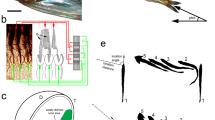Summary
The results of this study reveal that rainbow trout (Oncorhyncus mykiss formerly Salmo gairdneri) are capable of orienting to polarized light fields, and that the degree of polarization of the polarized light field affects the accuracy of orientation behavior. As previously shown, rainbow trout can accurately orient to a plane polarized light field after several sessions of food-rewarded training. The present data demonstrate that the accuracy of such orientation decreases the degree of polarization of the plane-polarized light field is lowered. In testing sessions, different concentrations of latex beads were introduced into a cuvette positioned below the light source to degrade the degree of polarization. There was evidence that trout could still detect the evector and use it in making orienting responses when the light was only 65% polarized. However, most of the test trout did not demonstrate orienting ability at levels of polarization below the 75% level.
Similar content being viewed by others
References
Batschelet E (1981) Circular statistics in biology. Academic Press, London
Baylor ER, Smith FE (1953) The orientation of Cladocera to polarized light. Am Nat 87:97–101
Bernard GD, Wehner R (1977) Functional similarities between polarization vision and colour vision. Vision Res 17:1019–1028
Dill PA (1971) Perception of polarized light by yearling sockeye salmon. J Fish Res Bd Can 28:1319–1322
Groot C (1965) On the orientation of young sockeye salmon (Oncorhyncus nerka) during their seaward migration out of the lakes. Behavior [Suppl] 14:198
Forward RB, Horch DW, Waterman TH (1972) Visual orientation at the water surface by the teleost Zenarchopterus sp. Biol Bull 143:112–126
Forward RB, Waterman TH (1973) Evidence for e-vector and light intensity pattern discrimination by the teleost Dermogenys sp. J Comp Physiol 87:189–202
Frisch K von (1949) Die Polarisation des Himmelslichtes als orientierender Faktor bei den Tänzen der Bienen. Experientia 4:142–148
Hawryshyn CW, McFarland WN (1987) Cone photoreceptor mechanisms and the detection of polarized light in fish. J Comp Physiol A 160:459–465
Hawryshyn CW, Arnold MG, Bowering E, Cole RL (1990) Spatial orientation of rainbow trout to plane-polarized light: The ontogeny of e-vector discrimination and spectral sensitivity characteristics. J Comp Physiol A 166:565–574
Ivanoff A (1974) Polarization measurements in the sea. In: Jerlov NG, Neilsen ES (eds) Optical aspects of oceanography. Academic Press, London, pp 151–175
Ivanoff A, Waterman TH (1958) Factors, mainly depth and wavelength, affecting the degree of underwater light polarization. J Mar Res 16:283–307
Jerlov NG (1963) Optical oceanography. Ocean Mar Biol Annu Rev 1:89–114
Jerlov NG (1976) Optical oceanography. Elsevier, Amsterdam
Kleerekoper H, Matis JH, Timms AM, Gesler P (1973) Locomotor response of the goldfish to polarized light and its e-vector. J Comp Physiol 86:27–36
Konnen GP (1985) Polarized light in nature. Cambridge University Press, Cambridge, pp 172
Kreithen ML, Keeton WT (1974) Detection of polarized light by the homing pigeon, Columba livia. J Comp Physiol 89:83–92
Lythgoe JN (1979) The ecology of vision. Oxford Press, New York
Lythgoe JN, Hemming CC (1967). Polarized light and underwater vision. Nature 213:893–894
Rossel S, Wehner R (1986) Polarization vision in bees. Nature (Lond) 323:128–131
Shaw SR (1966) Polarized light responses from crab retinula cells. Nature 211:92–93
Taylor DH, Adler K (1973) Spatial orientation by salamanders using plane polarized light. Science 181:285–287
Waterman TH (1975) Natural polarized light and e-vector discrimination by vertebrates. In: Evans GC, Bainbridge R, Rackham O (eds) Light as an ecological factor. Blackwell, Oxford London, pp 305–355
Waterman TH, Forward RB (1972) Field demonstration of polarotaxis in the fish Zenarchopterus sp. J Exp Zool 180:33–54
Wehner R (1976) Polarized-light navigation by insects. Sci Am 235:106–115
Zolotov V, Frantsevich L (1973) Orientation of bees by the polarized light of a limited area of the sky. J Comp Physiol 85:25–36
Author information
Authors and Affiliations
Rights and permissions
About this article
Cite this article
Hawryshyn, C.W., Bolger, A.E. Spatial orientation of trout to partially polarized light. J Comp Physiol A 167, 691–697 (1990). https://doi.org/10.1007/BF00192663
Accepted:
Issue Date:
DOI: https://doi.org/10.1007/BF00192663



